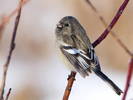search
classification
|
basic information
|
Long-tailed Rosefinch
Uragus sibiricus (Pallas, 1773)

|
 male
|
|
|
2015-12-18
Barnaul. Turina gora. |
© Vladimir Maer
|
|
Biology
Rare resident. Inhabits the willow-birch thickets on hassock marshes with horsetail grass, sedge and other vegetation. On dispersal and wintering (until the end of April) visits the deciduous forests with bush undergrowth, the riparian forests, gardens and thickets of tall weeds. Breeds in separate pairs quite a far one from another, in non-breeding seasons is in flocks of 5-15 birds. Nest is located in bushes at height 1-2 m above the ground; nest is built from the dry grass, leaves and bast and is lined with thin parts of plants, hair and feathers. Mainly female builds the nest for 4-7 days. Clutch of 3-6 (usually 4) eggs is laid in June. Mainly female incubates clutch for 13-14 days. Both parents feed juveniles which fledge at age 13-14 days old. One brood was feeding by parents noticed in August 13, 1946 in Irtysh valley. As soon as dispersal begins in end of September - early October birds appear outside of breeding area. At Chokpak Pass one bird observed in March 6, 1970. Latest birds in spring recorded in end of March – early April.
References










